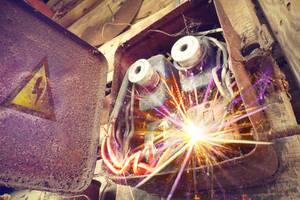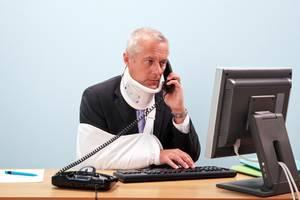Recent Blog Posts
What Types of Injuries Do and Do Not Qualify for Workers’ Comp?

For people who are injured while at work, workers’ compensation can provide them with benefits that address the effects of their injuries. To ensure that they will be able to make a full recovery, medical benefits will fully cover all expenses related to the treatment a person receives. If a person will miss work or lose income because of their injuries, they may qualify for temporary disability benefits while they are recovering, or they may receive permanent disability benefits to address an injury that will affect their ability to work and earn income in the future. While these benefits will be available for injuries that are considered to be work-related, some confusion may arise about whether a specific type of injury is covered by workers’ comp.
Common Workers Compensation Injuries for Truck and Delivery Drivers
 Truck drivers and delivery drivers are an increasingly important part of our economy. The volume of trucks on the road has been increasing in California and is projected to continue to grow. If you drive for a living or driving is part of your job, you know the risks you run every time you get behind the wheel. You can face danger not just from other vehicles on the road but also from the repetitive stresses of driving and from loading or unloading cargo.
Truck drivers and delivery drivers are an increasingly important part of our economy. The volume of trucks on the road has been increasing in California and is projected to continue to grow. If you drive for a living or driving is part of your job, you know the risks you run every time you get behind the wheel. You can face danger not just from other vehicles on the road but also from the repetitive stresses of driving and from loading or unloading cargo.
Types of Injuries Truck Drivers and Delivery Drivers Suffer
Traffic-related accidents account for most of the serious work-related injuries and deaths of truck drivers. If you are involved in a traffic accident, your injuries may have a wide range of severity, including:
-
Minor cuts and bruises
-
Fractures and serious sprains
How Are Permanent Disabilities Handled in California Workers’ Comp Cases?
 When a person suffers a work-related injury, they will usually be able to receive workers’ compensation benefits. Employers are required to maintain workers’ compensation insurance, and their policies provide coverage for all employees who are injured in workplace accidents or for other reasons that are related to the work they have performed. Workers’ comp provides multiple types of benefits, including medical benefits that pay for all treatment a person receives following an injury, as well as disability benefits that address their loss of income. In many cases, disability benefits are temporary, and they will allow a person to continue receiving pay while they are recovering from their injuries. However, in cases where injuries will affect a person for the rest of their life, permanent disability benefits may be paid.
When a person suffers a work-related injury, they will usually be able to receive workers’ compensation benefits. Employers are required to maintain workers’ compensation insurance, and their policies provide coverage for all employees who are injured in workplace accidents or for other reasons that are related to the work they have performed. Workers’ comp provides multiple types of benefits, including medical benefits that pay for all treatment a person receives following an injury, as well as disability benefits that address their loss of income. In many cases, disability benefits are temporary, and they will allow a person to continue receiving pay while they are recovering from their injuries. However, in cases where injuries will affect a person for the rest of their life, permanent disability benefits may be paid.
Types of Injuries That Can Occur in Workplace Slip and Fall Accidents
 There are many different types of accidents that may happen in the workplace, and in these situations, workers will need to understand their rights and options. Slip and fall accidents are among the most common causes of work-related injuries. Even though these may seem like minor incidents that will not result in long-lasting harm, they can cause a variety of injuries that may affect a person in the days and weeks following an accident. In some cases, they can result in ongoing health issues or permanent disabilities. Workers who are injured in fall accidents will need to understand the types of workers’ compensation benefits they can receive to address the effects of their injuries.
There are many different types of accidents that may happen in the workplace, and in these situations, workers will need to understand their rights and options. Slip and fall accidents are among the most common causes of work-related injuries. Even though these may seem like minor incidents that will not result in long-lasting harm, they can cause a variety of injuries that may affect a person in the days and weeks following an accident. In some cases, they can result in ongoing health issues or permanent disabilities. Workers who are injured in fall accidents will need to understand the types of workers’ compensation benefits they can receive to address the effects of their injuries.
Common Slip and Fall Injuries
There are many reasons why slip and fall accidents may occur, including wet floors, damaged sidewalks, potholes in parking lots, or tripping hazards such as torn carpets or extension cords in an office or other locations. A person who slips and falls may experience injuries such as:
What Are My Options if I Am Injured at Work by Faulty Equipment?
 There are many reasons why work injuries occur. While some injuries may be the fault of an employee who did not follow the correct safety practices, many are caused by the negligence of other parties. In some cases, an employer may fail to provide employees with the proper safety equipment or training, or they may fail to ensure that equipment is properly maintained. Equipment-related injuries may also occur due to design or manufacturing defects. Fortunately for people who are injured by faulty or defective equipment while on the job, workers’ compensation benefits will usually be available to address their medical expenses and any temporary or permanent disabilities. By understanding the types of equipment-related injuries that can occur and the steps they can take following an injury, a person can make sure they will be able to receive the benefits they deserve.
There are many reasons why work injuries occur. While some injuries may be the fault of an employee who did not follow the correct safety practices, many are caused by the negligence of other parties. In some cases, an employer may fail to provide employees with the proper safety equipment or training, or they may fail to ensure that equipment is properly maintained. Equipment-related injuries may also occur due to design or manufacturing defects. Fortunately for people who are injured by faulty or defective equipment while on the job, workers’ compensation benefits will usually be available to address their medical expenses and any temporary or permanent disabilities. By understanding the types of equipment-related injuries that can occur and the steps they can take following an injury, a person can make sure they will be able to receive the benefits they deserve.
When Will the Workers’ Compensation Appeals Board Review a Denied Claim?
 For those who are injured while on the job, workers’ compensation can provide essential benefits, ensuring that their medical care will be paid for and that they will be compensated for some of the income they have lost. However, there are some situations where workers’ comp claims may be denied. In these cases, injured workers will need to understand their options for filing an appeal, including when their case may be heard by the California Workers’ Compensation Appeals Board (WCAB).
For those who are injured while on the job, workers’ compensation can provide essential benefits, ensuring that their medical care will be paid for and that they will be compensated for some of the income they have lost. However, there are some situations where workers’ comp claims may be denied. In these cases, injured workers will need to understand their options for filing an appeal, including when their case may be heard by the California Workers’ Compensation Appeals Board (WCAB).
Requests for Reconsideration Before the WCAB
While all work-related injuries should be covered by workers’ compensation, regardless of who was at fault, there are a variety of reasons why a person may be denied benefits. An employer or their insurance company may believe that a person’s injuries were not work-related, or they may claim that certain types of medical treatment are not necessary. Disputes may also arise regarding whether an injury has resulted in a disability, and a worker may be denied temporary or permanent benefits that should address the loss of income they have experienced.
How Long Do Temporary Disability Benefits Through Workers’ Comp Last?
 A serious injury can cause a great deal of difficulty in a person’s life, but those who are injured while working will often be eligible for workers’ compensation benefits that can ease some of the burden. When an injury is serious enough that it limits a person’s ability to work while they are recovering, temporary disability benefits will provide the person with compensation for some of the income they have lost. However, as the name implies, these benefits will only last for a certain amount of time, and workers who are subject to limitations on the work they can perform following an injury will need to understand how long they can receive benefits.
A serious injury can cause a great deal of difficulty in a person’s life, but those who are injured while working will often be eligible for workers’ compensation benefits that can ease some of the burden. When an injury is serious enough that it limits a person’s ability to work while they are recovering, temporary disability benefits will provide the person with compensation for some of the income they have lost. However, as the name implies, these benefits will only last for a certain amount of time, and workers who are subject to limitations on the work they can perform following an injury will need to understand how long they can receive benefits.
Understanding the Limits on TTD and TPD Benefits
A person will be eligible for temporary disability benefits if they require overnight hospitalization following an injury or if the doctor who provides treatment following an injury determines that they will be unable to return to work for at least three days. Temporary disability benefits will provide compensation for the income lost due to the inability to work at the level that would allow a person to earn the wages they received before they were injured.
Can Office Workers Get Workers’ Comp for Repetitive Stress Injuries?
 When people think of workplace injuries, they are likely to picture serious accidents that result in significant bodily harm. While the need for workers’ compensation benefits may be evident in these cases, there are a variety of other injuries that workers can experience. Even though working in an office is not considered to be a high-risk occupation, office workers can be injured in multiple ways. These workers may experience repetitive stress injuries that may be caused by several different factors. Fortunately, all employees are eligible to receive workers’ comp for injuries that arose out of the work they have performed. By understanding the different types of repetitive stress injuries that may occur, office workers can make sure they provide the correct information to qualify for benefits.
When people think of workplace injuries, they are likely to picture serious accidents that result in significant bodily harm. While the need for workers’ compensation benefits may be evident in these cases, there are a variety of other injuries that workers can experience. Even though working in an office is not considered to be a high-risk occupation, office workers can be injured in multiple ways. These workers may experience repetitive stress injuries that may be caused by several different factors. Fortunately, all employees are eligible to receive workers’ comp for injuries that arose out of the work they have performed. By understanding the different types of repetitive stress injuries that may occur, office workers can make sure they provide the correct information to qualify for benefits.
Types of Repetitive Stress Injuries Affecting Office Workers
What Are the Most Common Causes of Workplace Fall Accidents?
 While there are multiple types of workplace accidents that occur on a daily basis, falls are some of the most common causes of injuries for workers. While these accidents can be especially serious for people in certain occupations, such as construction workers, they can affect employees in any industry. Fortunately, workers who are injured due to a fall that took place while they are working will usually qualify for workers’ compensation, even if they were responsible for their own injuries. By understanding the reasons that falls can occur in the workplace, workers can take the proper steps to avoid being injured while also ensuring that they will be able to receive benefits for any injuries that do occur.
While there are multiple types of workplace accidents that occur on a daily basis, falls are some of the most common causes of injuries for workers. While these accidents can be especially serious for people in certain occupations, such as construction workers, they can affect employees in any industry. Fortunately, workers who are injured due to a fall that took place while they are working will usually qualify for workers’ compensation, even if they were responsible for their own injuries. By understanding the reasons that falls can occur in the workplace, workers can take the proper steps to avoid being injured while also ensuring that they will be able to receive benefits for any injuries that do occur.
Slips, Trips, and Other Types of Fall Accidents
How Can Workers’ Compensation Address Traumatic Brain Injuries?
 Workplace accidents can occur for a variety of reasons, and when these accidents result in injuries, a person will usually be eligible to receive workers’ compensation benefits. Brain and head injuries can be especially harmful, and those who experience these types of injuries will want to be sure they take the correct steps to receive the proper medical treatment. They will also want to determine how they can receive benefits that address the ways an injury has affected their ability to work in the future.
Workplace accidents can occur for a variety of reasons, and when these accidents result in injuries, a person will usually be eligible to receive workers’ compensation benefits. Brain and head injuries can be especially harmful, and those who experience these types of injuries will want to be sure they take the correct steps to receive the proper medical treatment. They will also want to determine how they can receive benefits that address the ways an injury has affected their ability to work in the future.
Benefits for Workplace Brain Injuries
There are a variety of situations where workplace accidents may cause a person to experience a blow to the head that results in a traumatic brain injury (TBI). Fall accidents, including those involving a slip and fall due to a wet floor or a fall from a defective ladder or scaffolding, may cause a person to strike their head on the floor or other objects. Brain injuries may also occur if a person is struck on the head by falling objects at a construction site or in a car accident that occurs while a person is working.








